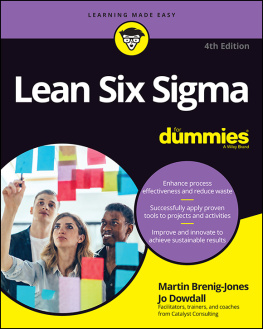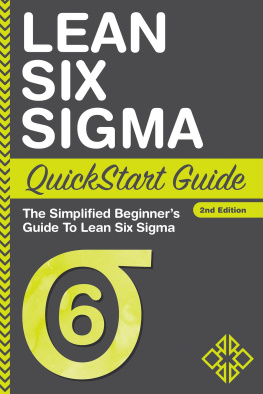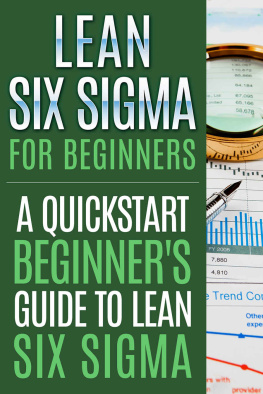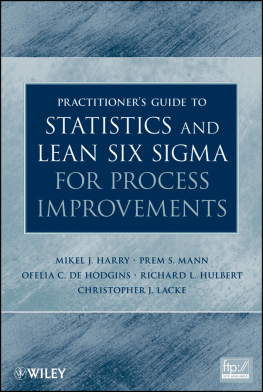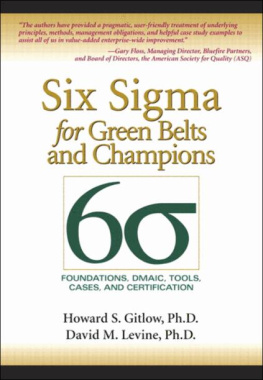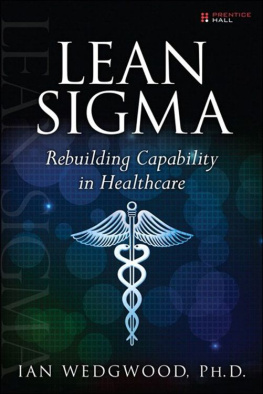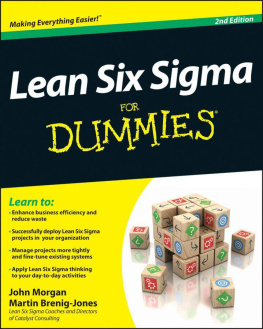The Lean Six Sigma Pocket Toolbook
A Quick Reference Guide to Nearly 100 Tools for Improving Process Quality, Speed, and Complexity
Michael L. George
David Rowlands
Mark Price
John Maxey
with contributions from
Paul Jaminet Kimberly Watson-Hemphill Chuck Cox


Copyright 2005 by George Group. All rights reserved. Except as permitted under the United States Copyright Act of 1976, no part of this publication may be reproduced or distributed in any form or by any means, or stored in a database or retrieval system, without the prior written permission of the publisher.
ISBN: 978-0-07-150573-4
MHID: 0-07-150573-3
The material in this eBook also appears in the print version of this title: ISBN: 978-0-07-144119-3, MHID: 0-07-144119-0.
All trademarks are trademarks of their respective owners. Rather than put a trademark symbol after every occurrence of a trademarked name, we use names in an editorial fashion only, and to the benefit of the trademark owner, with no intention of infringement of the trademark. Where such designations appear in this book, they have been printed with initial caps.
McGraw-Hill eBooks are available at special quantity discounts to use as premiums and sales promotions, or for use in corporate training programs. To contact a representative please e-mail us at bulksales@mcgraw-hill.com.
This publication is designed to provide accurate and authoritative information in regard to the subject matter covered. It is sold with the understanding that neither the author nor the publisher is engaged in rendering legal, accounting, or other professional services. If legal advice or other expert assistance is required, the services of a competent professional person should be sought.
From a Declaration of Principles jointly adopted by a Committee of the American Bar Association and a Committee of Publishers
TERMS OF USE
This is a copyrighted work and The McGraw-Hill Companies, Inc. (McGraw-Hill) and its licensors reserve all rights in and to the work. Use of this work is subject to these terms. Except as permitted under the Copyright Act of 1976 and the right to store and retrieve one copy of the work, you may not decompile, disassemble, reverse engineer, reproduce, modify, create derivative works based upon, transmit, distribute, disseminate, sell, publish or sublicense the work or any part of it without McGraw-Hills prior consent. You may use the work for your own noncommercial and personal use; any other use of the work is strictly prohibited. Your right to use the work may be terminated if you fail to comply with these terms.
THE WORK IS PROVIDED AS IS. McGRAW-HILL AND ITS LICENSORS MAKE NO GUARANTEES OR WARRANTIES AS TO THE ACCURACY, ADEQUACY OR COMPLETENESS OF OR RESULTS TO BE OBTAINED FROM USING THE WORK, INCLUDING ANY INFORMATION THAT CAN BE ACCESSED THROUGH THE WORK VIA HYPERLINK OR OTHERWISE, AND EXPRESSLY DISCLAIM ANY WARRANTY, EXPRESS OR IMPLIED, INCLUDING BUT NOT LIMITED TO IMPLIED WARRANTIES OF MERCHANTABILITY OR FITNESS FOR A PARTICULAR PURPOSE. McGraw-Hill and its licensors do not warrant or guarantee that the functions contained in the work will meet your requirements or that its operation will be uninterrupted or error free. Neither McGraw-Hill nor its licensors shall be liable to you or anyone else for any inaccuracy, error or omission, regardless of cause, in the work or for any damages resulting there from. McGraw-Hill has no responsibility for the content of any information accessed through the work. Under no circumstances shall McGraw-Hill and/or its licensors be liable for any indirect, incidental, special, punitive, consequential or similar damages that result from the use of or inability to use the work, even if any of them has been advised of the possibility of such damages. This limitation of liability shall apply to any claim or cause whatsoever whether such claim or cause arises in contract, tort or otherwise.
Acknowledgments
It takes a lot of expertise to make a book like this a reality. Wed like to thank Bill Lawson, Malcolm Upton, Bill Kastle, Kim Bruce, Stephen Wilson, and everyone else at George Group who lent their expertise. Writing, editorial, and layout kudos to Sue Reynard; proofing courtesy of Brenda Quinn; graphics support by Lawson Communications.
Contents
CHAPTER 1
Using DMAIC to Improve Speed, Quality, and Cost
DMAIC (pronounced Duh-MAY-ick) is a structured problem-solving methodology widely used in business. The letters are an acronym for the five phases of Six Sigma improvement: Define-Measure-Analyze-Improve-Control. These phases lead a team logically from defining a problem through implementing solutions linked to underlying causes, and establishing best practices to make sure the solutions stay in place.

When to use DMAIC
The structure of DMAIC encourages creative thinking within boundaries such as keeping the basic process, product, or service. If your process is so badly broken that you need to start over from scratch or if youre designing a new product, service, or process, use Design for Lean Six Sigma (DMEDI), not covered in this book.
Selecting DMAIC projects
This book assumes that most readers will work on DMAIC projects selected for them by managers or sponsors. (If this is not the case and you are involved in the project selection process, see p. 26 at the end of this chapter for a quick overview.
Implementation Options for DMAIC
There are two primary options for implementing DMAIC:
1) Project-team approach
Black Belts deployed full-time to projects
Team members work on the project part-timework on the project is interspersed with regular work
Full involvement by all team members in all phases of DMAIC
Duration can be 1 to 4 months depending on scope (some go longer; shorter is better because you can realize gains more quickly)
2) Kaizen approach
Rapid (1 week or less), intense progress through all of DMAIC except full-scale implementation
Preparatory work on Define, and sometimes on Measure, done by a subgroup (team leader and a Black Belt, for instance)
Rest of the work done by the full group during several days or a week when they work ONLY on the project (participants are pulled off their regular jobs)
The basic DMAIC steps (pp. 4 to 19) apply to both of these models. Additional guidance on conducting a Kaizen project is provided on pp. 20 to 25.
Do we have to follow all of DMAIC?
DMAIC is a valuable tool that helps people find permanent solutions to long-standing or tricky business problems. The basic framework works well in a wide variety of situations, but using DMAIC does involve time and expense. So you should weigh the costs of using DMAIC against the benefits and the costs of skipping some steps or jumping right into solutions. Two indicators that you should follow all of DMAIC:


